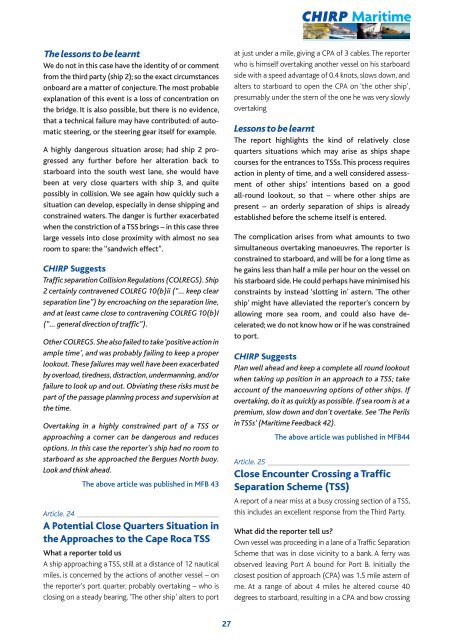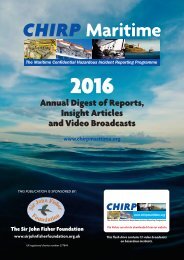CHIRP annual digest 2016 6th
Create successful ePaper yourself
Turn your PDF publications into a flip-book with our unique Google optimized e-Paper software.
<strong>CHIRP</strong> Maritime<br />
The lessons to be learnt<br />
We do not in this case have the identity of or comment<br />
from the third party (ship 2); so the exact circumstances<br />
onboard are a matter of conjecture. The most probable<br />
explanation of this event is a loss of concentration on<br />
the bridge. It is also possible, but there is no evidence,<br />
that a technical failure may have contributed: of auto -<br />
matic steering, or the steering gear itself for example.<br />
A highly dangerous situation arose; had ship 2 pro -<br />
gressed any further before her alteration back to<br />
starboard into the south west lane, she would have<br />
been at very close quarters with ship 3, and quite<br />
possibly in collision. We see again how quickly such a<br />
situation can develop, especially in dense shipping and<br />
constrained waters. The danger is further exacerbated<br />
when the constriction of a TSS brings – in this case three<br />
large vessels into close proximity with almost no sea<br />
room to spare: the “sandwich effect”.<br />
<strong>CHIRP</strong> Suggests<br />
Traffic separation Collision Regulations (COLREGS). Ship<br />
2 certainly contravened COLREG 10(b)ii (“… keep clear<br />
separation line”) by encroaching on the separation line,<br />
and at least came close to contravening COLREG 10(b)I<br />
(“… general direction of traffic”).<br />
Other COLREGS. She also failed to take ‘positive action in<br />
ample time’, and was probably failing to keep a proper<br />
lookout. These failures may well have been exacerbated<br />
by overload, tiredness, distraction, undermanning, and/or<br />
failure to look up and out. Obviating these risks must be<br />
part of the passage planning process and supervision at<br />
the time.<br />
Overtaking in a highly constrained part of a TSS or<br />
approaching a corner can be dangerous and reduces<br />
options. In this case the reporter’s ship had no room to<br />
starboard as she approached the Bergues North buoy.<br />
Look and think ahead.<br />
The above article was published in MFB 43<br />
Article. 24<br />
A Potential Close Quarters Situation in<br />
the Approaches to the Cape Roca TSS<br />
What a reporter told us<br />
A ship approaching a TSS, still at a distance of 12 nautical<br />
miles, is concerned by the actions of another vessel – on<br />
the reporter’s port quarter, probably overtaking – who is<br />
closing on a steady bearing. ‘The other ship’ alters to port<br />
at just under a mile, giving a CPA of 3 cables. The reporter<br />
who is himself overtaking another vessel on his starboard<br />
side with a speed advantage of 0.4 knots, slows down, and<br />
alters to starboard to open the CPA on ‘the other ship’,<br />
presumably under the stern of the one he was very slowly<br />
overtaking<br />
Lessons to be learnt<br />
The report highlights the kind of relatively close<br />
quarters situations which may arise as ships shape<br />
courses for the entrances to TSSs. This process requires<br />
action in plenty of time, and a well considered assess -<br />
ment of other ships’ intentions based on a good<br />
all-round lookout, so that – where other ships are<br />
present – an orderly separation of ships is already<br />
established before the scheme itself is entered.<br />
The complication arises from what amounts to two<br />
simultaneous overtaking manoeuvres. The reporter is<br />
constrained to starboard, and will be for a long time as<br />
he gains less than half a mile per hour on the vessel on<br />
his starboard side. He could perhaps have minimised his<br />
constraints by instead ‘slotting in’ astern. ‘The other<br />
ship’ might have alleviated the reporter’s concern by<br />
allowing more sea room, and could also have de -<br />
celerated; we do not know how or if he was constrained<br />
to port.<br />
<strong>CHIRP</strong> Suggests<br />
Plan well ahead and keep a complete all round lookout<br />
when taking up position in an approach to a TSS; take<br />
account of the manoeuvring options of other ships. If<br />
overtaking, do it as quickly as possible. If sea room is at a<br />
premium, slow down and don’t overtake. See ‘The Perils<br />
in TSSs’ (Maritime Feedback 42).<br />
The above article was published in MFB44<br />
Article. 25<br />
Close Encounter Crossing a Traffic<br />
Separation Scheme (TSS)<br />
A report of a near miss at a busy crossing section of a TSS,<br />
this includes an excellent response from the Third Party.<br />
What did the reporter tell us?<br />
Own vessel was proceeding in a lane of a Traffic Separation<br />
Scheme that was in close vicinity to a bank. A ferry was<br />
observed leaving Port A bound for Port B. Initially the<br />
closest position of approach (CPA) was 1.5 mile astern of<br />
me. At a range of about 4 miles he altered course 40<br />
degrees to starboard, resulting in a CPA and bow crossing<br />
27



